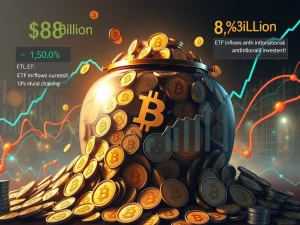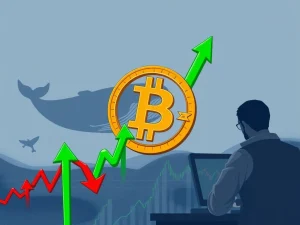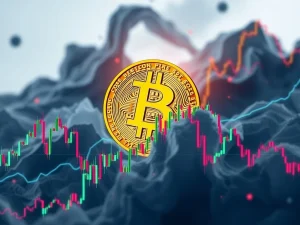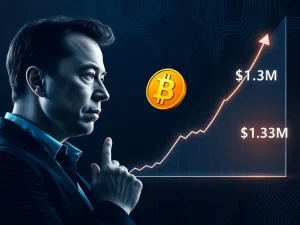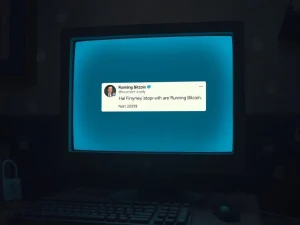Unveiling the Controversial Truth: Bitcoin Taproot’s Unforeseen Impact
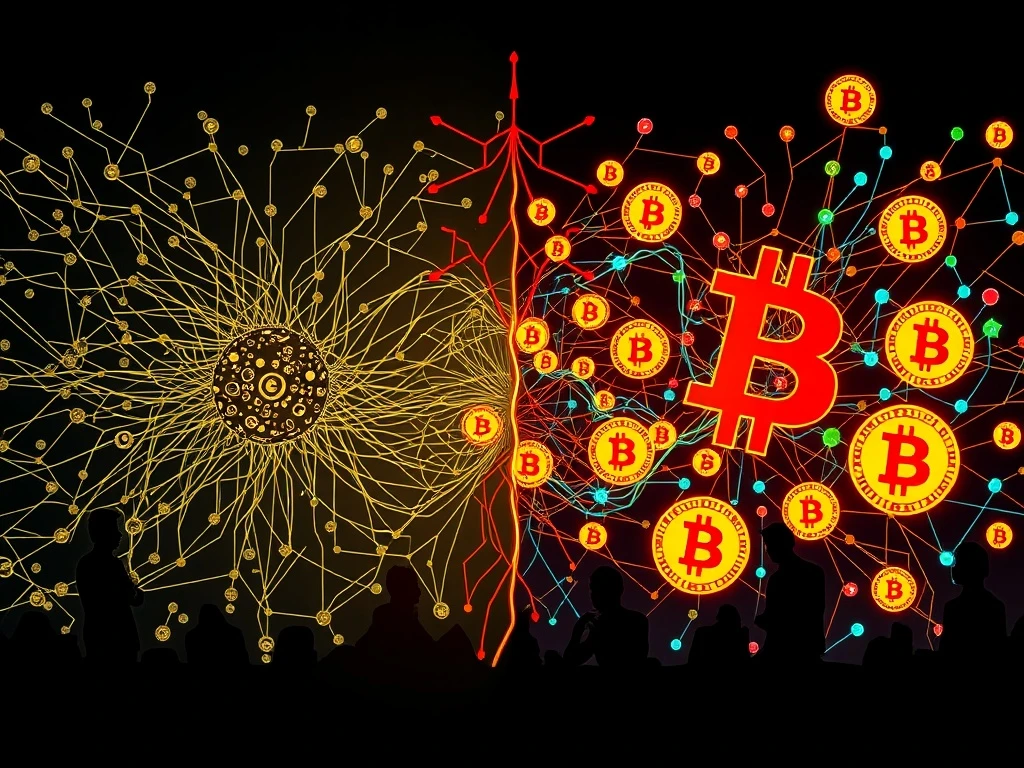
The Bitcoin network has always been a battleground of ideas. Few upgrades have sparked as much debate as Taproot. Activated in November 2021, the upgrade promised enhanced privacy and efficiency. However, a prominent Bitcoin developer, Jimmy Song, suggests its creators overlooked a critical aspect: its ‘trolling value.’ This unexpected outcome has fueled a significant ideological divide within the community, especially concerning the emergence of Bitcoin Ordinals and BRC-20s.
The Original Promise of Bitcoin Taproot
The Bitcoin Taproot upgrade represented a significant technical advancement for the network. Its primary goals included improving transaction privacy, reducing transaction costs, and enhancing the flexibility of smart contracts. Developers Jonas Nick, Tim Ruffing, and A.J. Townes, building on Gregory Maxwell’s 2018 concept, championed these improvements. Key features like Schnorr signatures and Script Paths Spend were central to Taproot’s design. These innovations aimed to make complex transactions, such as multisig setups, appear as simple single-signature transactions on the blockchain. This would theoretically boost privacy and efficiency for users.
For instance, Schnorr signatures were touted as a more efficient alternative to traditional multisig. They could allow multiple participants to sign a transaction, consolidating their signatures into one. This would save block space and improve transaction privacy. Similarly, Script Paths Spend aimed to simplify conditional spending. Users could define multiple conditions for spending funds, with only the met condition being revealed on the blockchain. These features promised a more robust and private future for the Bitcoin network.
Unforeseen Consequences: The Rise of Bitcoin Ordinals
Despite its technical merits, the Bitcoin Taproot upgrade has not fully delivered on its initial promises, according to Jimmy Song. He contends that the upgrade’s architects did not foresee its ‘social attack surface.’ This oversight, he argues, directly enabled the proliferation of non-financial transactions. These include Ordinals, BRC-20s, and other data types that now flood the network. Song refers to this phenomenon as Taproot’s ‘trolling value,’ highlighting the unexpected way the upgrade has been utilized.
Song points out that features like Schnorr signatures and Script Paths Spend, while technically sound, encountered practical hurdles. He claims their implementation proved more complicated than traditional multisig solutions, requiring additional signature rounds. “Bad user experience basically made it a non-starter,” Song asserted. This technical complexity, coupled with the ability to embed larger data segments, paved the way for the creation of Bitcoin Ordinals. These unique digital artifacts leverage Taproot to inscribe data directly onto individual satoshis, turning them into NFTs.
A Deep Divide Among Bitcoin Developers
The emergence of Ordinals and BRC-20s has intensified an existing ideological rift among Bitcoin developers. One camp, including figures like Adam Back, Dennis Porter, Luke Dashjr, and Jimmy Song, advocates for Bitcoin’s singular focus. They believe Bitcoin should remain a peer-to-peer electronic cash system, strictly adhering to Satoshi Nakamoto’s original vision. For them, transactions should primarily involve financial transfers, aiming to ‘fix money’ rather than accommodate diverse data types. They view non-financial transactions as ‘spam’ that clogs the network and deviates from its core purpose.
Conversely, another group of Bitcoin developers and enthusiasts has embraced Taproot’s expanded capabilities. Leaders like ‘Leonidas,’ a prominent figure in the Bitcoin Ordinals community, actively utilize the upgrade for creating Ordinals and Runes applications. This camp firmly believes that the Bitcoin network should remain uncensored. They argue that all valid transactions, regardless of their nature, should be processed without discrimination. This fundamental disagreement has sparked what some call the ‘Bitcoin Core vs. Bitcoin Knots war,’ reflecting the deep ideological chasm.
The Bitcoin Core vs. Bitcoin Knots Debate
The controversy surrounding non-financial transactions reached a critical point with the debate over the OP_RETURN function. In June, over 30 Bitcoin Core developers agreed to remove the 80-byte limit on this function. This change would allow for significantly more pictures, audio, videos, and documents to be stored directly on-chain. This decision was a major win for proponents of Ordinals and similar applications.
However, fears persist that Bitcoin Core, the leading Bitcoin software node operator, might reverse this update. This uncertainty has prompted a notable shift in allegiance within the community. Many users and developers are now considering or actively moving to Bitcoin Knots, an alternative Bitcoin client. Leonidas, from the Ordinals community, even stated that his group might consider forking Bitcoin Core. This drastic measure would occur if developers reversed the update and attempted to censor Ordinals, Runes, or other non-financial transactions on the Bitcoin network. This ongoing tension highlights the struggle for the future direction of Bitcoin’s development.
Strengthening the Bitcoin Network: The Role of Bitcoin Fees
While Jimmy Song remains critical of Taproot’s current applications, he acknowledges its potential for future benefits. “Taproot can, of course, redeem itself,” he stated. He suggests that innovations like Ark potentially decentralizing mining, or BitVM creating increased Bitcoin demand, could validate the upgrade. However, he concludes that “so far, Taproot has not lived up to the cost users paid to get it.” This nuanced view underscores the ongoing evaluation of Taproot’s long-term value.
On the other side, Leonidas champions the economic contributions of Ordinals and Runes. He argues that these applications have significantly strengthened the Bitcoin network by generating substantial transaction fees. These fees, totaling over $500 million, help offset the decreasing block subsidy for miners. This financial support becomes increasingly vital as Bitcoin’s block reward halves every four years. However, the reliance on these fees introduces volatility. Dune Analytics data shows daily Ordinals inscription fees ranging widely, from $3,060 to $537,400 in 2025. This volatility highlights the unpredictable nature of these new revenue streams. The peak of $9.99 million recorded on December 16, 2023, contrasts sharply with the typical daily figures, illustrating the fluctuating impact on overall Bitcoin fees.
The Future of Bitcoin Taproot and Network Evolution
The debate surrounding Bitcoin Taproot, Ordinals, and the broader use of the Bitcoin network continues to evolve. This ongoing discussion reflects a fundamental tension within the cryptocurrency space: whether a blockchain should maintain a narrow, focused utility or embrace broader, more diverse applications. The ideological divide among Bitcoin developers is not merely a technical disagreement; it represents differing visions for Bitcoin’s identity and future role in the digital economy. As the network matures, the community will undoubtedly face more such challenges. The ability to adapt while maintaining its core principles will define Bitcoin’s long-term trajectory. The outcomes of these debates will significantly shape how Bitcoin is perceived and utilized globally.

